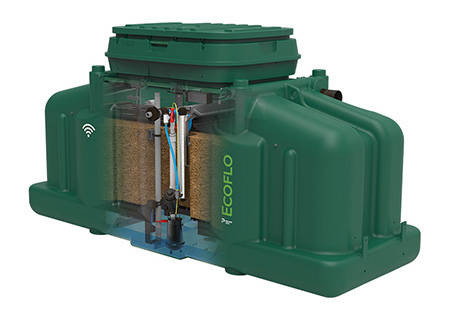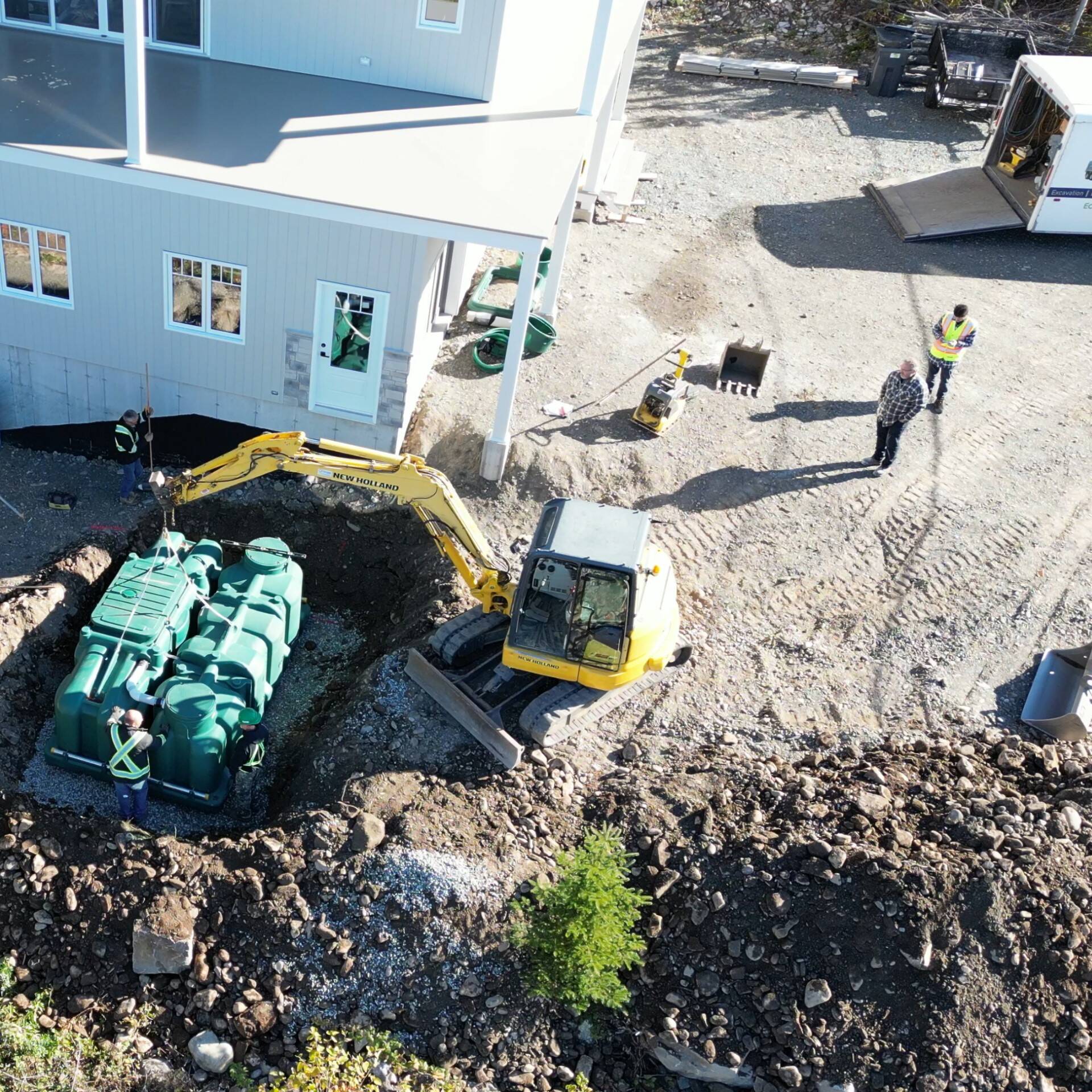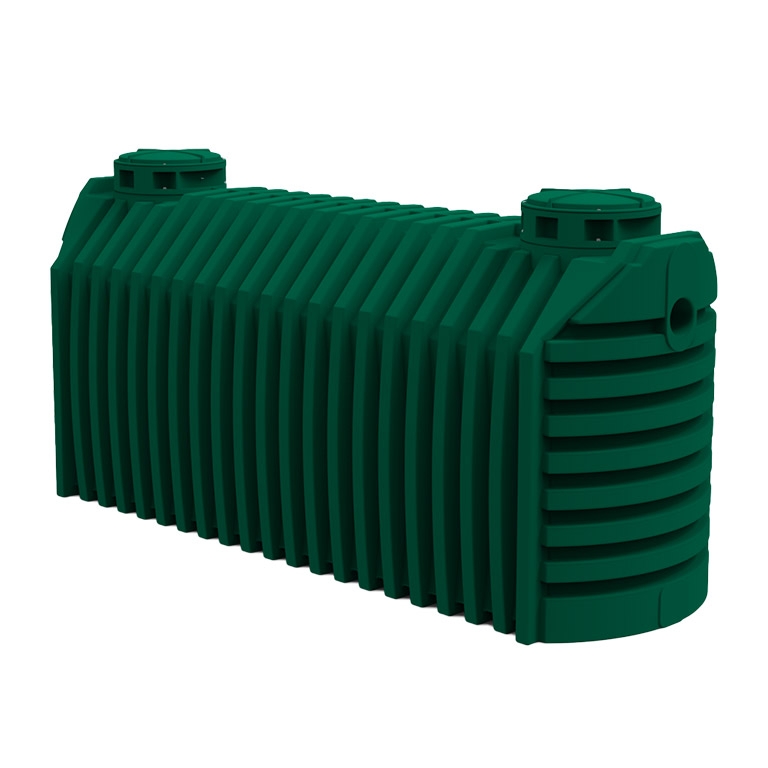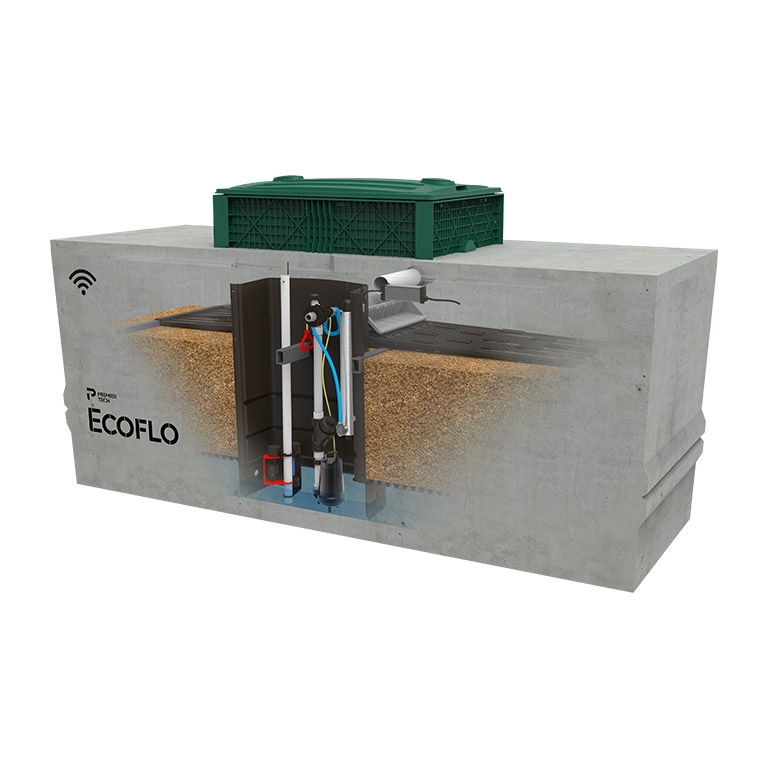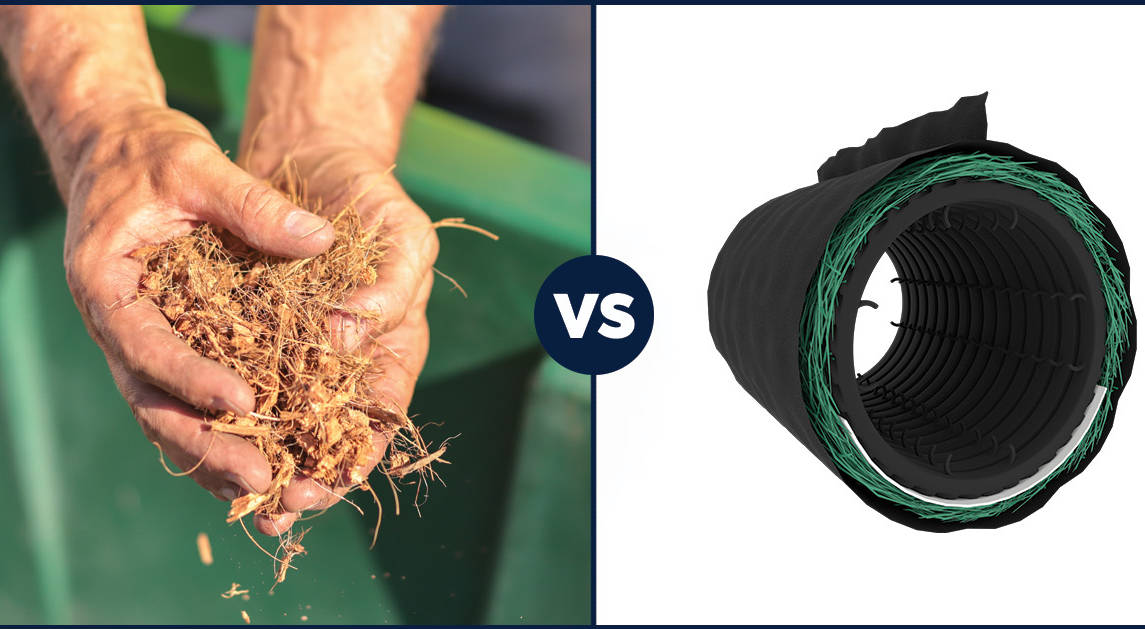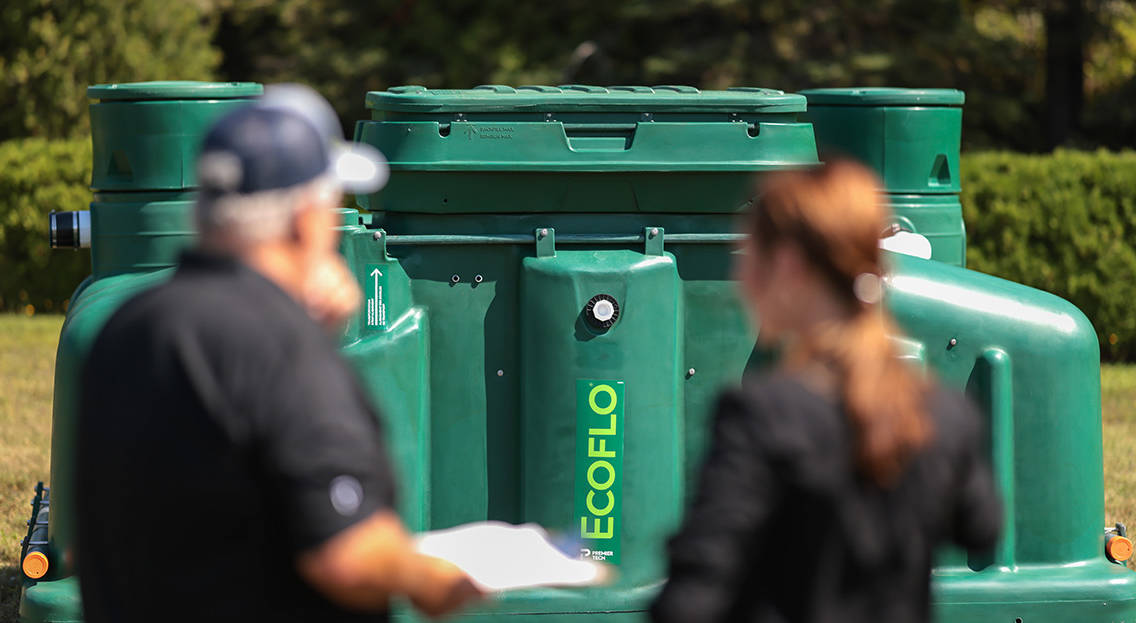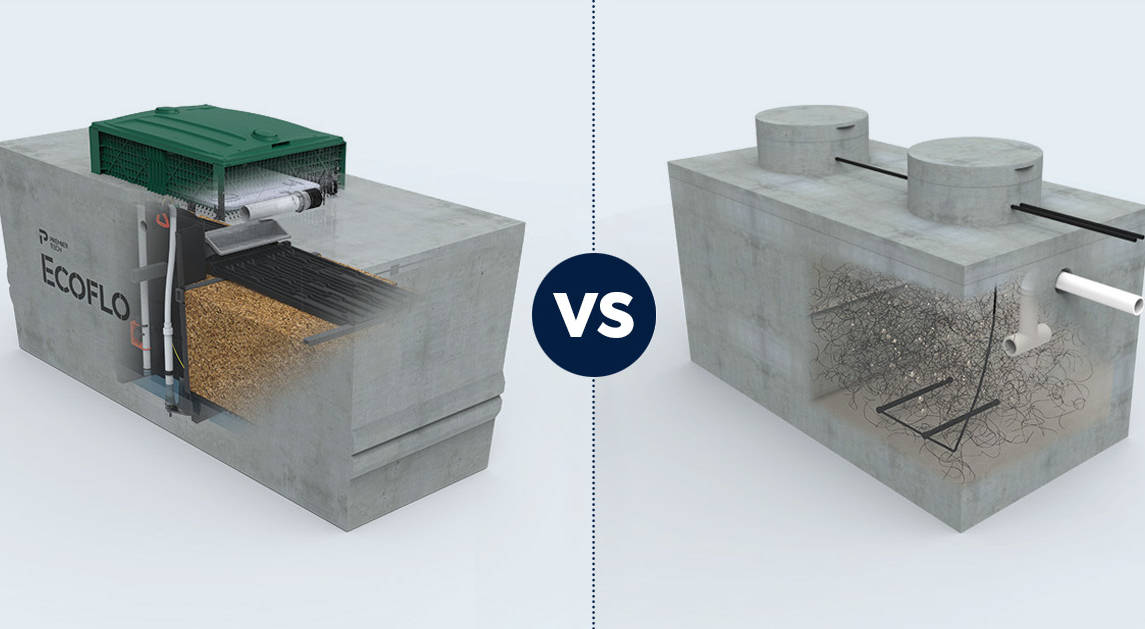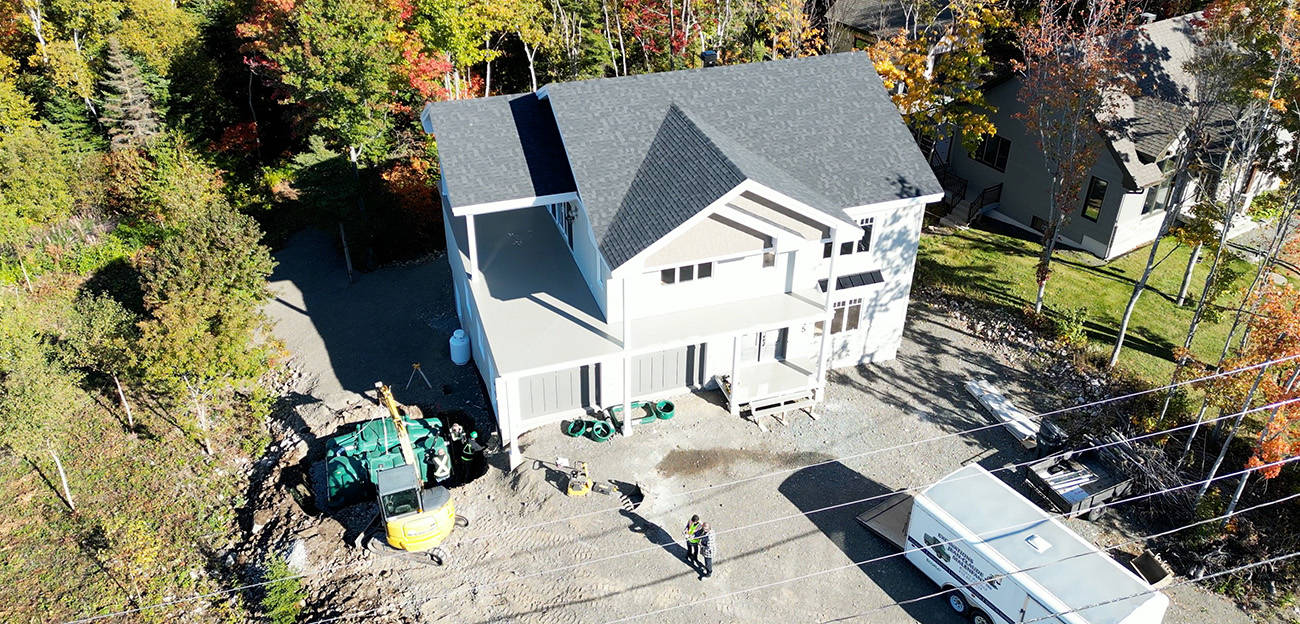
Building your dream home in the country is exciting, but if your lot is small, choosing the right septic system can be a real challenge.
Small septic systems offer a practical solution for properties with limited space, ensuring effective wastewater treatment where larger systems won’t fit. Whether you're constructing a year-round residence or a holiday retreat, finding the best septic system for your small lot is crucial.
In this guide, we’ll walk you through the key considerations for septic systems with small footprints and explain why the Ecoflo compact biofilter stands out as the smart choice compared to other alternatives in the United States.
If you have a small property, several challenges can limit the space available for a traditional septic system:
- Required distances from property lines
Local regulations require septic systems to be installed at a minimum distance from property lines (10 ft in most states). Keeping this distance is important for safety and to ensure your system functions properly. For small lots, these distances further reduce the available space for traditional septic systems, which require a sizable drain field (also known as a leach field).
- Required distances from wells and streams
Local regulations also require minimum distances between septic systems and water sources. These regulations are meant to protect public health. Again, these distances further limit space for septic systems on small lots, especially when they’re near a lake or river.
- Yard features
Septic systems need a dedicated area that is clear of heavy objects, which can damage your tank or pipes. If you plan to build a driveway, pool, gazebo, or similar feature on your small lot, you may not have the space required for a septic tank with a conventional drain field.
- Established trees
Septic systems need to be installed a certain distance from trees. Although leafy canopies look great in your yard, roots from certain trees can damage septic tanks and pipes. For small properties, the minimum required distance may make a traditional septic system impossible unless you clear your established trees.
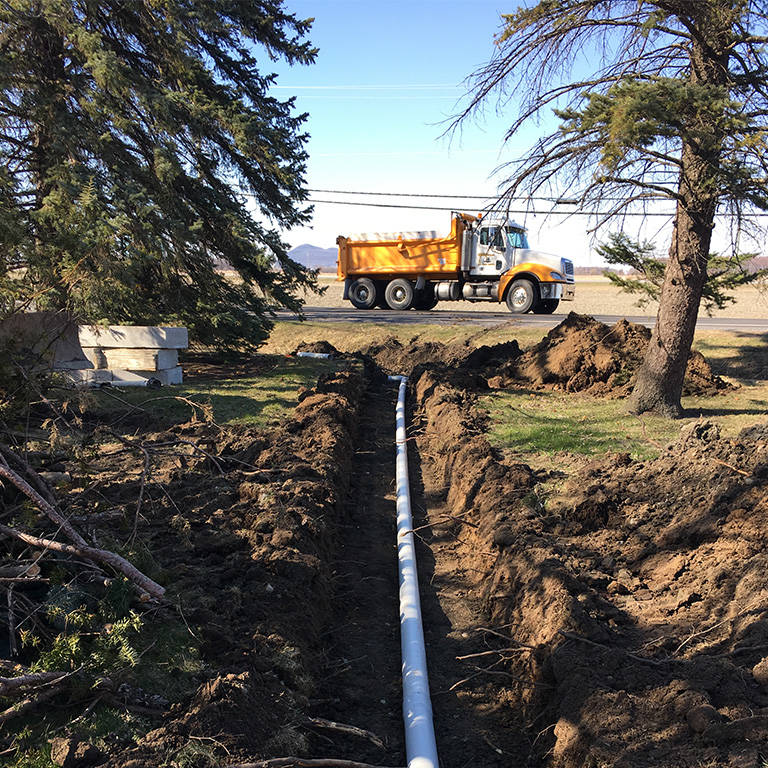
Installing a small septic system on a narrow lot with mature trees.
There’s no quick answer for how much space you need to install a septic system. That’s because the minimum amount of space is determined by criteria that are specific to each property. They include:
- Soil type and permeability
Wastewater needs to percolate through soil at a specific rate to be properly treated. Some soils percolate water too slowly, too quickly, or not at all. You could have 100 acres, but still not be able to install a septic system if you don’t have the right soil.
- Household size and water usage
A septic system designer will use the number of bedrooms in your home to estimate your water usage. Larger homes generate higher volumes of wastewater, which means they need bigger septic tanks and drain fields.
- Local regulations
Regulations around septic systems are different in each US state. They can even vary at the county level. These regulations determine everything needed to safely install a septic system on your property, including required setbacks and lot sizes.
Minimum lot size for a septic system in New Jersey
In New Jersey, septic system regulations are overseen by the New Jersey Department of Environmental Protection. However, there is no statewide minimum lot size due to varying local ordinances and site conditions.
A 1-acre (43,560 ft2) lot is often considered the practical minimum for a septic system in New Jersey. This ensures compliance with environmental and safety standards, as well as setbacks from wells and property lines.
This minimum can change based on your soil type, water table depth, septic system type, and local regulations. For more information about your property’s specific requirements, contact our team or the health department official in your area.
Minimum lot size for a septic system in Iowa
The Iowa Department of Natural Resources (DNR) does not enforce a specific statewide minimum lot size for septic systems. Instead, lot-size requirements depend on county regulations and the site conditions of your property.
Generally, a 1-acre (43,560 ft2) lot is considered the practical minimum in Iowa. This ensures adequate space for the septic system, a well (if applicable), and any required setbacks from property lines, water sources, or buildings.
Again, this minimum can change based on your soil conditions, the type of septic system you choose, and local regulations. For requirements tailored to your property, reach out to our team or consult a sanitarian from your county health department.
Minimum lot size for a septic system in Pennsylvania
The Pennsylvania Department of Environmental Protection does not set a statewide minimum lot size for septic systems due to the variability of local regulations and site-specific conditions.
However, as a general guideline, the minimum lot size for a septic system is typically around 1 acre (43,560 ft2) in Pennsylvania.
This can vary depending on factors such as soil conditions, the type of septic system, and municipal or county regulations. For requirements specific to your property, contact our team or consult the sewage enforcement officer (SEO) for your township.
Why is the Ecoflo compact biofilter the best septic system for small lots?
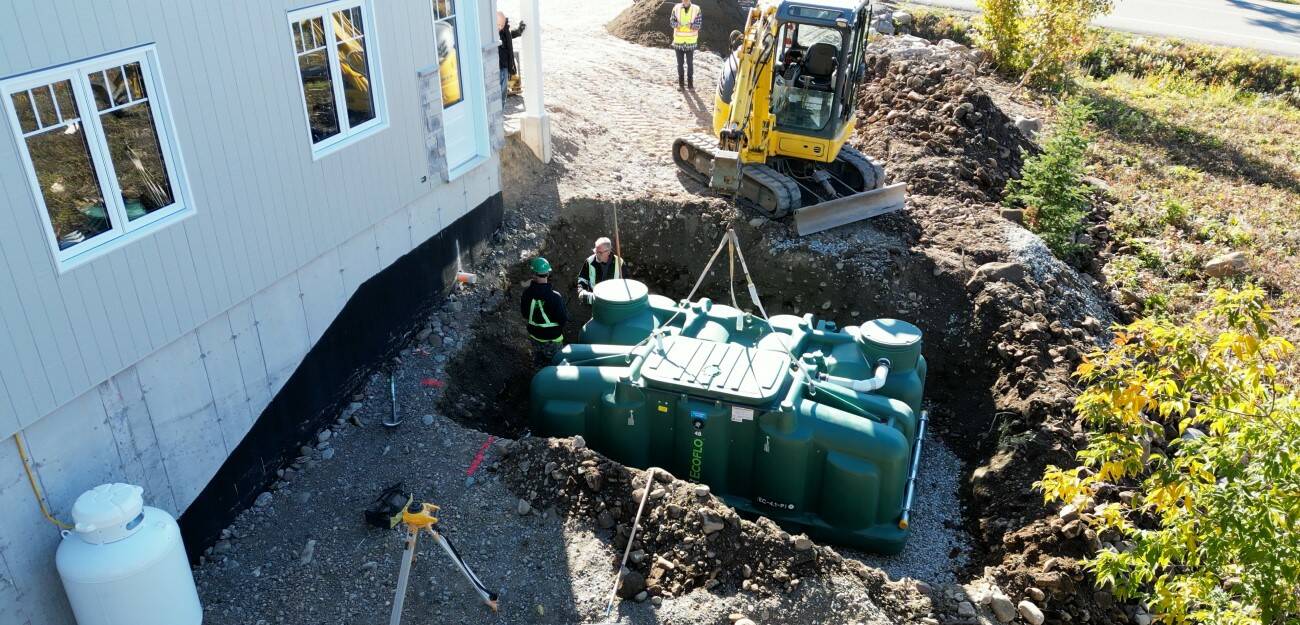
Ecoflo compact biofilter installation on a small lot.
If you have a small area where a traditional septic system won’t fit, you need to look for an alternative system to treat your wastewater.
The Ecoflo compact biofilter, manufactured by Premier Tech Water and Environment, is the perfect solution for small lots due to its compact design and long-term, efficient performance.
Compact size
Traditional septic systems have drain fields that take up a lot of space. This makes it hard to fit them onto small lots.
That isn’t a problem with the Ecoflo compact biofilter, which can be installed with a smaller drain field than traditional systems. This means you can often avoid clearing mature trees to make room for the installation.
Let’s compare drain field requirements for traditional septic systems versus the Ecoflo compact biofilter in a few different states. We’ll assume that each installation is for a three-bedroom home.
| State | Traditional drain field minimum (ft2) | Ecoflo compact biofilter drain field minimum (ft2) | Space saved with Ecoflo |
| Iowa | 500 | 0* | 100%* |
| New Jersey | 600 | 400 | 33% |
| Pennsylvania | 600 | 360 | 40% |
* In Iowa, Ecoflo compact biofilter effluent can be discharged directly into a stream or ditch, eliminating the need for a drain field. If a drain field is used, its minimum area is 281 ft², a 56% reduction compared to a traditional drain field.
The Ecoflo compact biofilter also comes in a Pack model that saves even more space by combining the septic tank and biofilter in one configuration. These models need only one excavation, making for a quick, easy installation.
Installed for life
Sludge is a natural byproduct of wastewater treatment. With other systems, it can accumulate in the drain field over time. This eventually causes the drain field to clog. Once that happens, you need to dig up the drain field and find space to install a new one.
Finding space for a drain field on small lots is already hard. Finding space for a second one can be impossible.
Thanks to the Ecoflo compact biofilter’s coco filter, that isn’t a problem. The filter acts as a physical barrier that traps pollutants. Any built-up sludge stays there, which protects your drain field from clogging.
Unlike your drain field, the Ecoflo compact biofilter is fully accessible. When its coco filter clogs (usually after 13 to 15 years of use), we remove it and install a new one in the same tank. The system itself is installed for life.
Learn more about how the Ecoflo compact biofilter works.
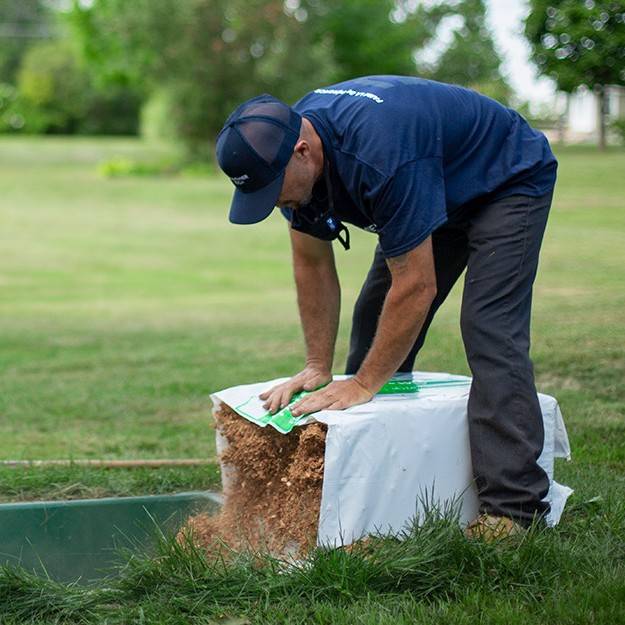
Installing a new coco filter in the Ecoflo compact biofilter.
Efficient treatment, even during periods of non-use
Some properties with small lots, such as cabins and holiday homes, aren’t occupied year-round. Because of this, they don’t use their septic systems all the time.
Unlike other septic systems, the Ecoflo compact biofilter is perfectly adapted for intermittent use.
Because it doesn’t use electricity for treatment, it doesn’t need to be turned on or off. And since it has no mechanical parts, you don’t need to worry about it malfunctioning when you’re not there.
Another reason is its coco filter. Coco has a high capacity for water retention and absorption. Thanks to this, the filter maintains a humid environment inside the biofilter unit, which sustains essential microorganisms during periods of non-use.
When you get back to your property after an absence, the Ecoflo compact biofilter will be just as you left it and ready to treat your property’s wastewater.
Integrated UV disinfection
Septic drain fields on lakefront lots and similar properties can be difficult (or even impossible) due to inadequate soil or insufficient distance from water sources.
In such cases, the septic system may need to discharge effluent directly into a nearby stream or ditch. This can be done by installing a UV disinfection unit, which ensures that your treated wastewater is safe for the surrounding environment.
The Ecoflo compact biofilter shines in these situations.
While they don't disinfect wastewater by themselves, many Ecoflo compact biofilter models allow for the integration of a UV system directly in the tank. This makes for a quick, compact installation that protects your property and the natural beauty around it.
Suitability for high bedrock
Ledge installations are challenging due to high bedrock, which complicates excavation and increases project costs. Space is also tight on these properties, as they don’t have a lot of flat surface area suitable for installation.
The Ecoflo compact biofilter offers an easy solution. Since the Pack model combines the septic tank and biofilter in a single configuration, it needs only one excavation. This, combined with the system’s smaller drain field, make it the ideal choice for ledge installations.
How does the Ecoflo compact biofilter compare with other alternative systems for small lots?
Septic systems are a long-term investment. That's why it's important to make the right choice for your property, now and for years to come.
To help you make your decision, let’s compare the Ecoflo compact biofilter with popular alternatives in a few different states: Iowa, New Jersey, and Pennsylvania.
In Iowa, flatbed biofilters are a popular alternative for rural properties with small lots.
Flatbed biofilters receive wastewater from your septic tank and disperse it over a synthetic filtering medium. Microorganisms attached to the filtering medium break down pollutants as wastewater trickles through. Effluent then flows into your drain field, where it returns to native soil.
Flatbed biofilters function much like the Ecoflo compact biofilter. Both systems are also installed for life. So, what’s the difference?
- Warranty
Iowa’s leading flatbed biofilter comes with a warranty that hard-stops after 20 years, no matter what.
By contrast, the Ecoflo compact biofilter’s filtering medium has a 10-year warranty that resets each time you renew your filter. This can extend your warranty indefinitely and protects your investment in your property.
- Number of components
Unlike flatbed biofilters, the Ecoflo compact biofilter does not require additional pumps to operate. That means it uses fewer components and has a smaller footprint on your property. You save even more space if you install the Ecoflo Pack model, which combines your septic tank and biofilter in one configuration.
- Easy access to records
Flatbed biofilter companies don’t centralize system records, which can make it harder for you to track down important information like installation dates, maintenance logs, or filter replacements.
As the manufacturer of the Ecoflo compact biofilter, Premier Tech keeps all your system records in one place, so you always have access to the details you need.
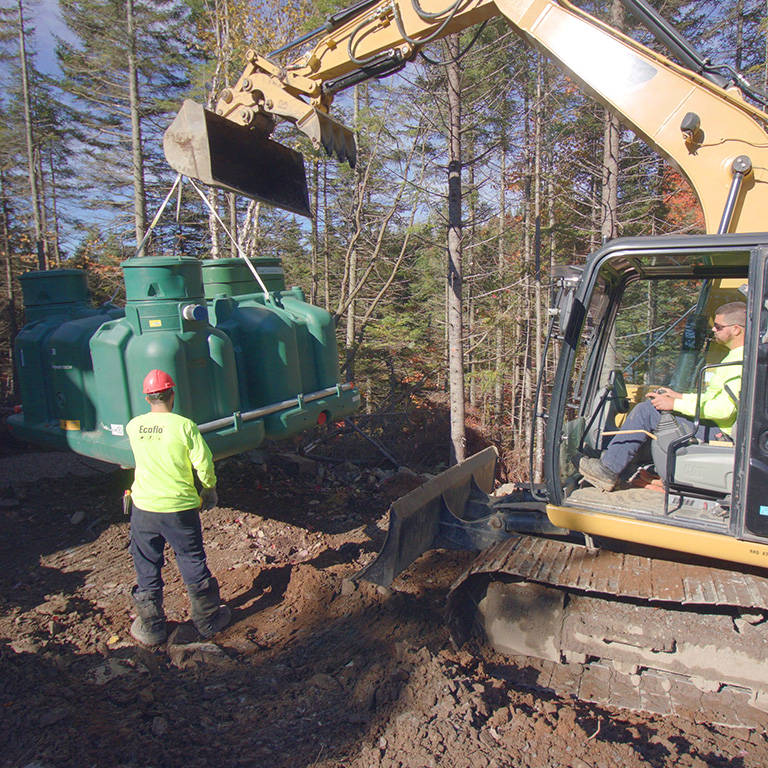
Ecoflo Pack model: combining the septic tank and biofilter in one configuration, which is not possible with flatbed biofilter systems.
Aerobic treatment units are a popular choice for small lots in New Jersey. These systems are installed as one unit with three separate chambers. Each plays a part in treating your wastewater:
- The first chamber acts as a septic tank. It partially clarifies your wastewater by separating sludge and scum.
- In the second chamber, a pump injects air to accelerate the growth of bacteria that break down pollutants.
- Remaining solids settle on the bottom of the third chamber. Effluent then flows into your drain field.
Aerobic treatment units and the Ecoflo compact biofilter are both adaptable to small lots. But Ecoflo stands out as the better choice in two key areas.
- Reliance on electricity
Aerobic treatment units require an air pump to sustain the bacteria that treat wastewater, making them vulnerable to power failures. This is especially challenging for seasonal properties that may be unoccupied for long periods.
Without electricity, bacteria in the system die, which can lead to untreated effluent leaking onto your property. When you return, the system needs time to rebuild its bacterial population before it can function properly.
The Ecoflo compact biofilter, on the other hand, uses no electricity for treatment. It doesn’t need to be turned on or off, and it requires no start-up time. Its coco filtering medium maintains a humid environment, keeping the bacteria alive and ready to treat wastewater.
- Ability to cope with extra wastewater
Aerobic treatment units struggle with sudden increases in wastewater flow because they have a smaller septic tank than other systems. The tank needs to be emptied more often and even a temporary increase in water usage, like during a party, can overwhelm the system. And, because the septic tank is integrated in the system, it can’t easily be upgraded to a bigger size.
This isn’t a problem with the Ecoflo compact biofilter. It can be paired with larger septic tanks, effectively handling higher wastewater volumes without the need for frequent emptying.
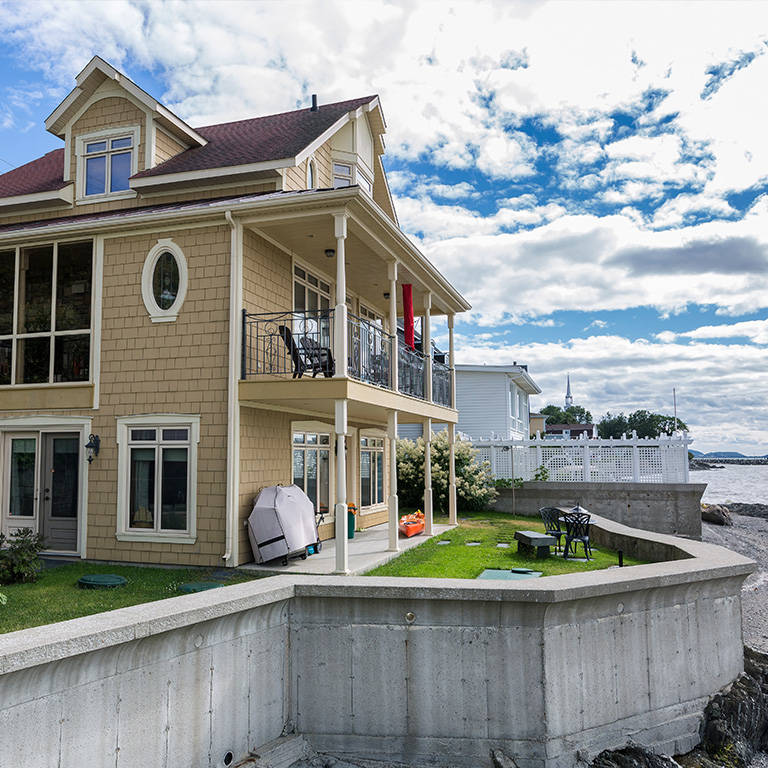
Ecoflo compact biofilter: perfect for small lots because it works 24/7 without electricity and handles fluctuating wastewater flows.
Geotextile sand filters (GSFs) are a popular septic system choice for small lots in Pennsylvania.
These systems work by pumping septic tank effluent to the top of a sand mound. Wastewater trickles through a geotextile module and continues through the sand layer. It then percolates into the underlying drain field, which completes treatment before effluent returns to native soil.
Because geotextile sand filters can be configured for narrow spaces, they are easy to install on properties with space constraints.
So why is the Ecoflo compact biofilter the better choice?
- Height
Geotextile sand filters have a sand mound and a geotextile module that protrude on your property, creating an eyesore.
The Ecoflo compact biofilter requires only an underlying stone layer, which is 10” shorter and far less obtrusive.
- Accessibility
Geotextile sand filters are buried with no way to access or monitor them. You won’t know if there’s a problem until the system starts to fail. By then, its too late to do anything except replace it.
The Ecoflo compact biofilter has an easily accessible lid. When its filter clogs after 13 to 15 years of use, all we need to do is pop open the lid, remove the old filter, and install a new one.
- Components
Geotextile sand filters rely on control panels and pumps to treat wastewater, which means they can’t function if either of these malfunctions or breaks.
The Ecoflo compact biofilter is a passive system that works 24/7 in all seasons. It does not need these extra components to treat your wastewater.
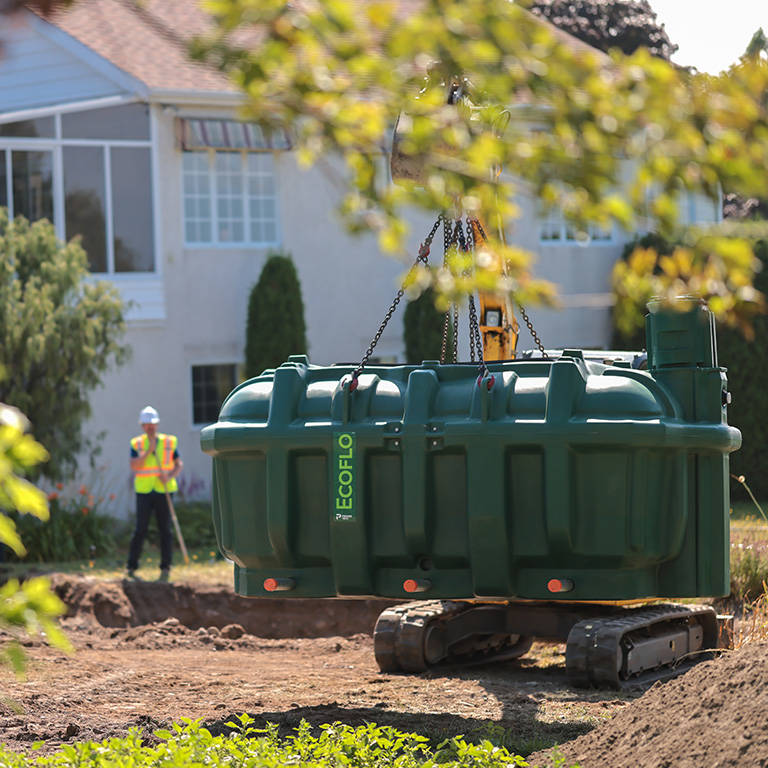
Ecoflo compact biofilter: fully accessible, 24/7 treatment in all seasons, and far more discreet than mounded GSF systems.
